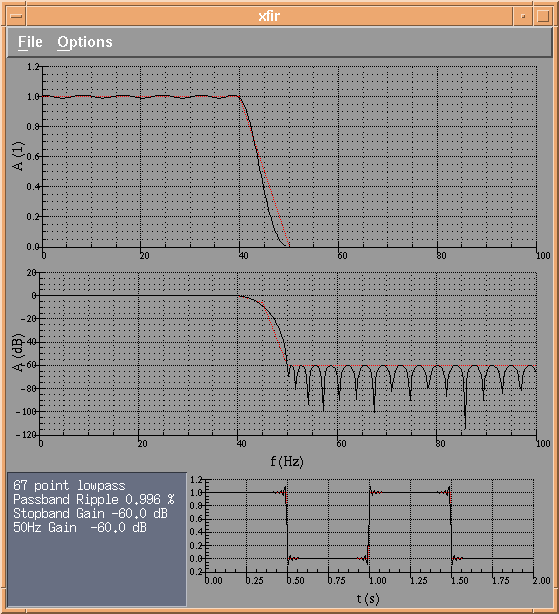
xfir screenshot
----------------------------------------------------------------------------- EEP 3.1 Max-Planck-Institute of Cognitive Neuroscience 1996-99 xfir 3.2 (OSF1 V4.0 alpha) Wed Sep 15 13:30:18 1999 ----------------------------------------------------------------------------- xfir [<fir>]
xfir is a X/Motif based Finite Impulse Response(FIR) Filter design program.
It allows the interactive design of the filter coefficient sets which are
needed by cntfilter, xcnt, avrfilter and xavr
to filter signals.The filter length must be an odd number and all the frequencies must have plausible values. The error checking is quite sensitive but the messages are spartan.
The Remez-Exchange design offers an Auto toggle. When set,
xfir ignores the given length and tries to find the shortest
filter which fullfills the given passband ripple and stopband
gain requirements. The optimization which is done here
is not very sophisticated. It is slow, it fails often to find any solution -
especially for "extreme" filters (see below) and you can stop it only
by cancelling the whole program...
xfir is integrated with the EEP viewer programs. With
Options - Export Now, the current filter is exported (surprise!) and all
instances of xcnt and/or xavr
at the same screen show how the data would look if they were
filtered with this coefficient set. With the Options - Export Always
toggle enabled, this is done automatically for each calculated filter. Note that
this can be slow for expensive filters.
The desired response is not displayed when the filter cofficients are loaded from a file. The design parameters are not reliably known in this case.
The lower diagram shows a sample 1 Hz rectangular pulse (red-dotted) and it's filtered version (black). The textfield lists some attributes and characteristic points of the actual filter.
xfir screenshot
n = 2 * fsample / fcritwhere fcrit is the lowest critical frequency in your design. Such a filter is long enough to cover 2 periods of the lowest interesting frequency and has a chance to handle it...
xfir are different from the
classic EEP 2.0 *.fir files. They store both the filter design
parameters and the calculated FIR coefficients. EEP 2.0 had a separate
configuration file for the design.
EEP 3.1 modules (xfir, xcnt, xavr, cntfilter, avrfilter) can read the
filter coefficients from both flavours of *.fir. xfir can read the
filter design only from its own files. The EEP 2.0 programs cannot read the
new *.fir files. Use your favourite text editor for conversions.
Some example fir files are available.
FIR LINEAR PHASE FILTER DESIGN PROGRAM
James H. McClellan, Thomas W. Parks, Lawrence R. Rabiner
Rorabaugh, Britt.
Digital Filter Designer's Handbook, McGraw-Hill 1993